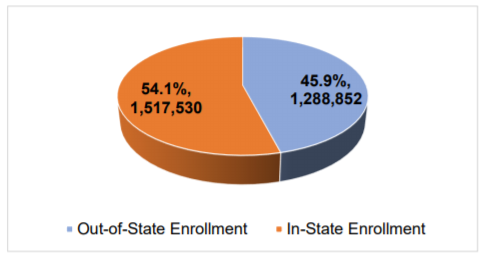You have /5 articles left.
Sign up for a free account or log in.

Istockphoto.com/metamorworks
Over 1.5 million students studied toward online degrees at institutions in their home state last year, according to new distance education data released today.
The National Council for State Authorization Reciprocity Agreements (NC-SARA) has been collecting data on the number of out-of-state students studying online for the past four years.
This year for the first time the report includes in-state students studying online in addition to out-of-state students studying online -- painting a much fuller picture of the online learning landscape.
Data collected from NC-SARA’s 1,960 member institutions (from every state but California) show that 2.8 million students studied in fully online degree programs in 2019. Of these, 1.5 million were in-state students and 1.3 million were out-of-state students. Out-of-state online enrollment grew by 5 percent compared with the 2018 data.
Before NC-SARA existed, individual states used to collect online enrollment data, but it was difficult to get a national picture, said Cheryl Dowd, director for the State Authorization Network at the WICHE Cooperative for Educational Technologies. “I appreciate that NC-SARA is providing consistency in the reporting,” she said.
While the federal Integrated Postsecondary Education Data System (IPEDS) requires institutions to report their distance education enrollment, it does not break down that enrollment by state. “It’s helpful for states and institutions to see who is going out of state and where they’re going,” said Dowd. The NC-SARA database makes it possible to track which states students at specific institutions come from.
 When it comes to picking a college, even online, proximity clearly matters to students. A 2019 survey by Wiley Education Services and Aslanian Research suggested that online students are increasingly choosing to study close to home. The NC-SARA report shows public institutions accounted for 53.2 percent of the total reported online enrollment in 2019. The vast majority of these learners, 80 percent, are in-state students.
When it comes to picking a college, even online, proximity clearly matters to students. A 2019 survey by Wiley Education Services and Aslanian Research suggested that online students are increasingly choosing to study close to home. The NC-SARA report shows public institutions accounted for 53.2 percent of the total reported online enrollment in 2019. The vast majority of these learners, 80 percent, are in-state students.
At private nonprofit institutions, however, a different picture emerges. At these institutions, 68 percent of a total 836,644 online students were enrolled from out of state. At private for-profit institutions, 92 percent of 475,505 students were out of state. Since 2017, online enrollments at for-profit institutions have declined by more than 100,000, despite a positive increase in 2018, the NC-SARA data suggest.
As public institutions tend to start out with a regional, rather than national, focus online, it makes sense that the majority of their online enrollments are in-state, said Dowd. Public universities tend to have strong local brand recognition and are typically slower than privates to market their online learning at a national level, she said.
With more than 47,000 students, the University of Maryland Global Campus had the largest fully online enrollment among public institutions, followed by Arizona State University and Purdue University Global. Western Governors University reported the largest online enrollment among private nonprofit institutions. The University of Phoenix reported the highest enrollment among private for-profit institutions, with 95,938 students.
In previous NC-SARA reports that did not count in-state online enrollment, no public institutions made the top 10 list of institutions by size of reported enrollment. This year, UM Global Campus came in at No. 6.
| Institution Name | State | Sector | Total Reported Online Enrollment |
|
Western Governors University |
Utah | Private nonprofit |
120,876 |
| University of Phoenix | Ariz. | Private for-profit | 95,938 |
| Southern New Hampshire University | N.H. | Private nonprofit | 95,832 |
| Grand Canyon University | Ariz. | Private nonprofit | 69,952 |
| Liberty University | Va. | Private nonprofit | 62,561 |
| University of Maryland Global Campus | Md. | Public | 47,537 |
| Strayer University | D.C. | Private for-profit | 43,765 |
| American Public University System | W. Va. |
Private for-profit |
43,573 |
| Ashworth College | Ga. | Private for-profit | 41,329 |
| Capella University | Minn. | Private for-profit | 36,915 |
“The data confirm what we knew anecdotally to be true -- a lot of public institutions are serving their state citizens with online learning,” said Lori Williams, CEO and president of NC-SARA. “We know that campus-based students tend to go to schools within a 50-mile radius of their home, and we thought that something similar was happening online. Now we have the data to support that assertion.”
Members of NC-SARA agree to shared national standards that make it easier for them to offer online programing across state lines. There are 49 states participating in the agreement, with the exception of California. The District of Columbia, Puerto Rico and the U.S. Virgin Islands also participate in the agreement.
Providing data to NC-SARA is a condition of being a member institution, said Marianne Boeke, director for policy research and state support at NC-SARA. This year the report had a 99.5 percent response rate, with exceptional circumstances preventing a small number of institutions from participating. “We’ve never had a repeat offender,” she said.
Boeke said she and her colleagues are mindful that they do not want to burden members with excessive data reporting requirements. But they want to make the data they collect as useful as possible to their state and institutional members, she said.
Tracking Learning Placements
This year, NC-SARA introduced a new addition to its report: exploring the number of students in online or on-campus programs participating in out-of-state learning placements. These include, for example, internships or clinical placements for students in medical fields. It’s a topical issue, given the looming federal requirement for institutions to make disclosures to all students about professional state licensure requirements, said Williams.
While NC-SARA institutions have been required to make professional licensure disclosures to students for some time, institutions still struggled to pinpoint how many students are engaging in experiential learning, said Boeke. “At the departmental level, administrators absolutely know where their students are and track them closely. But trying to filter that up to the institutional level has been tricky,” she said. “It’s going to take a while to get systems in place so that each institution can report this data efficiently and accurately.”
A total of 239,955 out-of-state learning placements were reported in 2019, but Boeke suspects this number is likely “on the conservative side.” The majority of these placements, 60.5 percent, were in health-related programs, followed by education (9.5 percent) and business (5 percent).
Some states and programmatic accreditors do collect information on where students find placements, particularly in highly regulated fields such as nursing, said Jennifer Mathes, interim CEO of the Online Learning Consortium. But it’s “not easy to pull that information together to get a national picture,” she said.
Both Mathes and Dowd said they would like to see these data being collected on a more granular basis in the future -- perhaps breaking down health-related placements by their associated program titles. But both said they understood that NC-SARA is being careful not to overburden their member institutions.
“They’re asking the right questions for their organization. I think they’ve got the balance just about right,” said Mathes.




